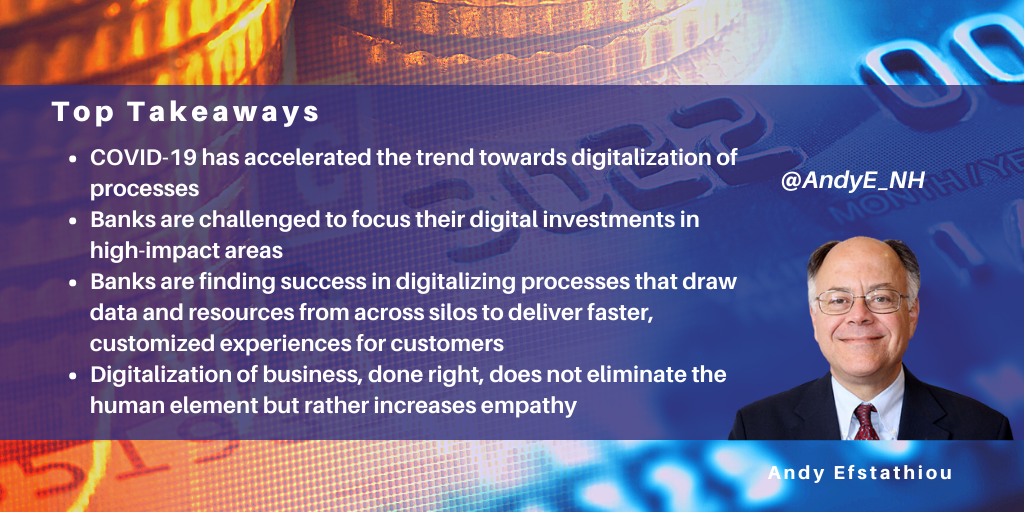Search posts by keywords:
Filter posts by author:
Related Reports
Related NEAT Reports
Other blog posts
posted on Oct 14, 2020 by Andy Efstathiou

I recently participated in a webinar panel during the Consumer Banking Association conference with Genpact and TD Bank. The panel topic was Genpact: Turning Crisis into Opportunity for Consumer Banking, and it addressed three core topics:
- The global health and economic crises have reshaped consumer banking
- Banks are adjusting to serve customers digitally while trying to maintain empathy and human connection
- Banks can accelerate and prioritize their digital investments to drive real change.
The COVID-19 crisis has accelerated previous trends towards digital adoption, including:
- Cloud migration, as banks have moved from a single cloud strategy to a hybrid, multi-cloud strategy
- Omnichannel migration, as banks close branches and expand online alternatives
- Cybersecurity adoption, as banks seek to secure their data and operations in the cloud.
TD Bank has found that banks have moved at light speed to implement the PPP Act and financial relief offers for customers. TD Bank’s relief offer, TD Cares, was built with three concepts in mind:
- What benefits do stressed customers need?
- What products can best deliver these benefits?
- Outreach to customers the bank anticipated might need support. The guiding principle is meeting the customer where they are (online, in-person, etc.).
The delivery of these services was developed with a “digital-first” approach, followed immediately with human interaction to support robust interaction and CSAT.
Overall, banks are trying to prioritize where they will be spending their money. When a bank looks at digitizing a process, such as onboarding or payments, where in the value chain should it start and focus their investment dollars to make the largest operational impact? The key to succeeding in delivering value is to optimize the customer experience. To date, banks have looked at improving their processes. However, customers are comparing their online experiences against their experiences form other industries, such as the consumer products or entertainment industries.
COVID-19 has forced banks to rethink how and when they engage customers. Key examples of changes made include:
- Much faster decision-making process (e.g., for lending). Digitalizing applications and providing STP to decisioning algorithms has enabled closer to real-time approvals for standard borrowing requests
- Real-time digital channels: by deploying armies of chatbots, AI, and decision trees; banks have been enabling employees to engage across all channels with customers while knowing who the customer is in real-time.
The banks are not just trying to improve efficiency, they are trying to create empathetic, differentiated experiences in their customer interactions. Creating a value chain that delivers digital, empathetic, differentiated customer experiences will require a synthesis of bank operations, data management, and FinTech partner ecosystems. By integrating digital processing, bank/customer data, and new functionality from an ecosystem of vendors, banks should be able to know each customer and create a custom experience for that customer. The industry is in the early stages of creating such customized experiences, but the journey has begun. For example, a bank has been able to deliver empathetic, customized experiences by digitalizing customer contact apps across silos. This requires all stakeholders to participate to move a project ahead both thoughtfully and at speed.
Banks are not just building customer contact experiences with digital technologies. The panel identified payments as an area of rapid transformation, where customers experience the use of the product itself as a consumer experience. There are two areas within payments that are a focus for innovation today:
- Payment initiation: identifying the payor at the POS to provide a seamless, real-time payment experience
- Post-payment services: delivery of services such as credit extension and loyalty program assignment.
Again, modularizing the process with support from an ecosystem of specialized vendors is enabling payment companies to restructure the industry and improve customer experience.
The key takeaways from the webinar panel are that, because of COVID-19, banks are moving faster than ever to digitalize their businesses. The digitalization of business does not eliminate the human element but rather increases empathy and human engagement to drive a differentiated experience. Because the canvas is large, banks are challenged to focus their investments in high-impact areas. The areas where banks are finding success are in digitalizing processes that draw data and resources from across silos to deliver faster, customized experiences for customers.

Oct 15, 2020, by David Vila